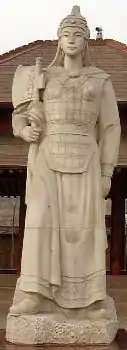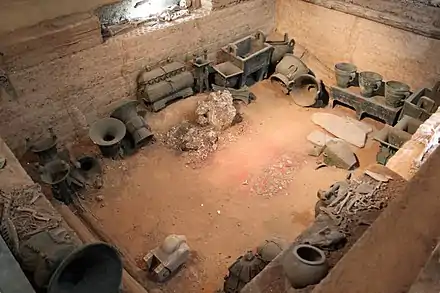Fu Hao
Fu Hao (traditional Chinese: 婦好; simplified Chinese: 妇好; pinyin: Fù Hǎo; lit. 'Lady [surnamed] Hao')[lower-alpha 1] died c. 1200 BC, posthumous temple name Mu Xin (母辛), was one of the many wives of King Wu Ding of the Shang dynasty and also served as a military general and high priestess.[2] Minimal evidence detailing Fu Hao's life and military achievements survived the Shang Dynasty, and the records may have perished over the course of time.
| Fu Hao | |
|---|---|
| Queen consort | |
 Modern statue of Fu Hao outside her tomb at Yinxu | |
| Spouse | King Wu Ding |
| Issue | Prince Jie |
| Dynasty | Shang |
| Occupation |
|
The Tomb of Fu Hao was unearthed intact at Yinxu by archaeologist Zheng Zhenxiang,[3][4] with treasures - known as her 700+ jade objects (Fu Hao was a collector, so some were already antiques), and also her collection of more than 500 bone objects, such as bone oracles (they were from her role as a religious priestess, and were used in her many rituals). Along with the jade and bone objects, Fu Hao was buried with 6 dogs, and 16 human sacrifices. Inside the pit was evidence of a wooden chamber 5 metres (16 feet) long, 3.5 metres (11 feet) wide and 1.3 metres (4.3 feet) high containing a lacquered wooden coffin that has since completely disintegrated.[5] The tomb of Fu Hao provides the most insight into her life, her relationship with the royal family, and her military role and achievements - as the objects she was buried with provide clues to her activities and interests.
Biography
What is known is that King Wu Ding cultivated the allegiance of neighbouring tribes by marrying one woman from each of them. Fu Hao (who was believed to be one of the king's 64 wives) entered the royal household through such a marriage and took advantage of the semi-matriarchal slave society to rise through the ranks[6] to become one of King Wu Ding's three consorts. The other two were Fu Jing (婦妌) and Fu Shi (婦嬕)[7] Fu Jing was the primary queen while Fu Hao was the secondary queen. Fu Hao was also the mother of Prince Zu Ji (祖己). Oracle bone inscriptions show concern for her well-being at the time of the birth.
The activities of priestess and ritual matters of China only exist in the Shang dynasty, so some evidence is vague. Since each Chinese Character like Fu 婦 often has variable meanings, even with the oracle bones of Shang deciphered, it is possible that some women like Fu Hao were originally priestess instead of the King's wife; she just happened to marry the King later. That is to say, the meaning of "wife" in some contexts may actually refer to a position as priestess.
Fu Hao owned her land. According to the oracle bones, she offered the King remarkably valuable tributes many times. Although the Shang king had control over ritual matters, which constituted the most important political activity of the day, oracle bone inscriptions show that Wu Ding repeatedly instructed Fu Hao to conduct the most special rituals and to offer sacrifices to the ancestors. The Shang Dynasty had two most important activities: ritual matters and battles; Lady Hao played extraordinary roles in both at that time.
Military role
Fu Hao is known to modern scholars mainly from inscriptions on Shang dynasty oracle bone artifacts unearthed at Yinxu.[8] From these inscriptions and from the presence of weapons in her tomb, it can be determined that Fu Hao was a general in charge of several military campaigns for the Shang Dynasty.[9]
In her military role, she was responsible for conquering enemies and neighbours of the Shang Dynasty.[10] The Tu-Fang had fought against the Shang for generations until they were finally defeated by Fu Hao in a single decisive battle. Further campaigns against the neighbouring Yi, Qiang and Ba followed; the latter is particularly remembered for being the earliest recorded large-scale ambush in Chinese history.[11] With up to 13,000 soldiers and important generals Zhi and Hou Gao serving under her, she was the most powerful Shang general of her time.[12]
This highly unusual status is confirmed by the many weapons, including great battle-axes, unearthed in her tomb.[5]
While Fu Hao's achievements were notable and unique, other women in this period were also active in military roles; in a similar manner Fu Jing was also thought to have served in the military based on the presence of many weapons and military equipment in her tomb. Oracle bones also revealed records of at least six hundred women participating in the military during this era.[13]
Tomb

Remarkably, after her death Fu Hao was buried in a tomb on her land across the river from the main royal cemetery, even though usually the royal families were buried together. She died well in advance of King Wu Ding, who constructed her tomb at his capital Yin.
Because of its location, Lady Hao's tomb is the only royal Shang tomb to have been left unnoticed and unlooted, giving unique insights into her life and the burial practices of the time. The King later made many sacrifices there in hopes of receiving her spiritual assistance in defeating the attacking Gong, who threatened to wipe out the Shang completely. This shows his great favor towards Hao and after her death, he had her married to the three greatest kings before him.[6] The tomb was unearthed by archaeologists in 1976 and is now open to the public.
The tomb itself was only a 5.6-by-4-meter (18 by 13 ft) pit that contains a smaller, 5-meter-long (16 ft), 3.5-meter-wide (11 ft), and 1.3-meter-high (4.3 ft) wooden structure within. The inside was packed with burial sacrifices and wealth which signified Lady Hao's prodigious position.
She was buried with a large and varied quantity of weapons signifying her important martial status, since only warriors and generals were buried with such objects. Additionally, Fu Hao was entombed with hundreds of bronze, jade, bone, and stone objects such as figurines, vessels, and mirrors many of them rare objects from around the kingdom. These objects are some of the best preserved we have from that time period. The sacrificial bronze vessels and tortoise shells inscribed prepared by Fu Hao discovered in her tomb are further evidence of her status as a high priestess and oracle caster.[5] As was the custom during the Shang Dynasty, Fu Hao was buried with 16 human sacrifices and six dogs.[14] The remains of Fu Hao herself were found to have disintegrated. [15]
Contents of tomb
In total, Fu Hao was buried with:[16]
- 755 jade objects
- 564 bone objects, including nearly 500 bone hairpins and over 20 bone arrowheads
- 468 bronze objects, including 130 weapons, 23 bells, 27 knives, 4 mirrors, and 4 tigers or tiger heads
- 63 stone objects
- 5 ivory objects
- 11 pottery objects
- 6,900 pieces of cowry shell (that Shang used as currency)
- 16 human sacrifices
- 6 dogs
Note
- Several scholars (Childs-Johnson (2003), Zhang Zhenglang (1983, 1986), Chung (1985), etc.) propose that 婦好 be read as Fù Zǐ (lit. "Lady [surnamed] Zi"), interpreting the graph 好 as a phono-semantic compound with phonetic 子 and radical 女, which was used "as a heraldic and function and gender classifier" to distinguish women's surnames from men's.[1]
References
- Childs-Johnson, Elizabeth. (2003) "Fu Zi: The Shang Woman Warrior" in The Fourth International Conference on Chinese Paleography [ICCP] Proceedings. Hong Kong: Chinese University of Hong Kong. p. 620 of 619-651.)
- Ebrey, Patricia (2006). The Cambridge Illustrated History of China. Cambridge University Press. pp. 26–27. ISBN 978-0-521-43519-2.
- Loewe & Shaughnessy 1999, pp. 194–196.
- "The First Lady of Chinese Archaeology". TrowelBlazers. Retrieved 18 October 2015.
- Buckley Ebrey, Patricia. "Shang Tomb of Fu Hao". A Visual Sourcebook of Chinese Civilization. University of Washington. Retrieved August 4, 2007.
- "Woman General Fu Hao". All China Women's Federation. Archived from the original on February 14, 2007. Retrieved August 4, 2007.
- Fu Shi can also be called Fu Yi (婦睪), and she is often referred to in the oracle bones as Bigui (Chinese: 妣癸).
- "The Tomb of Lady Fu Hao" (PDF). British Museum. Retrieved August 4, 2007.
- Wang, Robin (2003). Images of Women in Chinese Thought and Culture: Writings from the Pre-Qin Period Through the Song Dynasty. Hackett Publishing. ISBN 978-0872206519.
- Nelson, Sarah M. (2003). Ancient Queens: Archaeological Explorations. Rowman Altamira. ISBN 9780759103467.
- Nelson, Sarah M.; Rosen-Ayalon, Myriam (2002). In Pursuit of Gender: Worldwide Archaeological Approaches. Rowman Altamira. ISBN 9780759100879.
- "Fu Hao – Queen and top general of King Wuding of Shang". Color Q World. Retrieved August 4, 2007.
- Peterson, Barbara Bennett (2016-09-16). Notable Women of China: Shang Dynasty to the Early Twentieth Century. Routledge. ISBN 9781317463726.
- "FU HAO'S TOMB". depts.washington.edu. Retrieved 2018-10-25.
- "Ancient China: From the Neolothic Period to the Han Dynasty" (PDF). asianart.org. Retrieved 2022-02-24.
- YANG, BIN (2011). "The Rise and Fall of Cowrie Shells: The Asian Story". Journal of World History. 22 (1): 1–25. doi:10.1353/jwh.2011.0011. JSTOR 23011676. S2CID 162003115.
Sources
- Loewe, Michael; Shaughnessy, Edward L. (13 March 1999). The Cambridge History of Ancient China: From the Origins of Civilization to 221 BC. London: Cambridge University Press. ISBN 978-0-521-47030-8.
Further reading
- Allan, Sarah (2008). "Fu Hao". In Smith, Bonnie G. (ed.). The Oxford Encyclopedia Women in World History. Oxford: Oxford University Press. ISBN 978-0-19-514890-9. (subscription required)